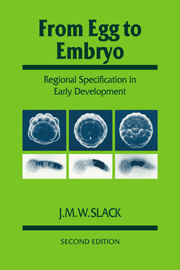Book contents
- Frontmatter
- Contents
- Preface to the second edition
- Preface to the first edition
- 1 Regional specification in animal development
- 2 The concepts of experimental embryology
- 3 Theoretical embryology
- 4 Hierarchies of developmental decisions
- 5 Development with a small cell number
- 6 Models for Man: the mouse and the chick
- 7 The breakthrough
- 8 What does it all mean?
- Appendix: How to write a program for development
- References
- Index
2 - The concepts of experimental embryology
Published online by Cambridge University Press: 16 October 2009
- Frontmatter
- Contents
- Preface to the second edition
- Preface to the first edition
- 1 Regional specification in animal development
- 2 The concepts of experimental embryology
- 3 Theoretical embryology
- 4 Hierarchies of developmental decisions
- 5 Development with a small cell number
- 6 Models for Man: the mouse and the chick
- 7 The breakthrough
- 8 What does it all mean?
- Appendix: How to write a program for development
- References
- Index
Summary
As we shall see, the techniques of molecular biology and genetics are now essential in the investigation of regional specification. But, historically it was the experimental embryologists who gave most thought to mechanism and who formulated the basic conceptual framework which enables us to discuss the problems rationally. In this Chapter an attempt will be made to present a vocabulary, based on classical embryology but supplemented with more recent concepts, which can serve as the currency for the arguments in the remainder of the book. Although an attempt has been made to conform as much as possible to common usage, the exigencies of precise definition ensure that some readers will find words used in different senses from those which they favour.
NORMAL DEVELOPMENT
Normal development means the course of development which a typical embryo follows when it is free from experimental disturbance. Most species used for laboratory work have ‘normal tables’ which break down the course of development into a number of standard stages. The existence of these tables emphasizes the predictability of normal development and enables investigators in different parts of the world to standardize their procedures. Normal development must not be confused with pathways of development which give a normal outcome.
- Type
- Chapter
- Information
- From Egg to EmbryoRegional Specification in Early Development, pp. 9 - 33Publisher: Cambridge University PressPrint publication year: 1991

